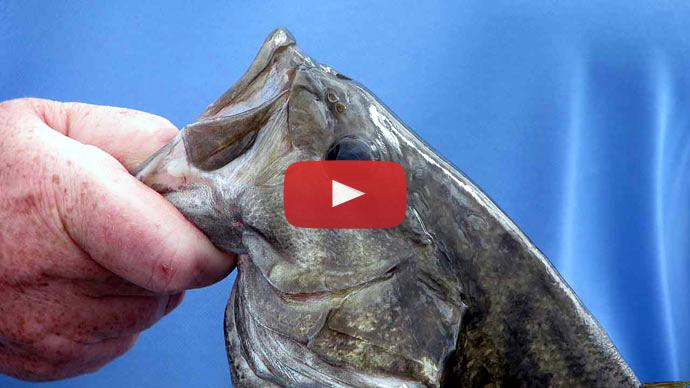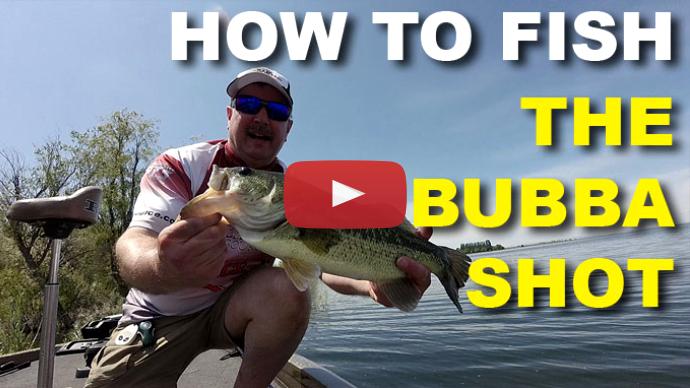There we are! Look at that. Woa! C'mere. These smallies sure like to fight good. There's two of them down there, there's one with him. A bigger one. I'll be danged. They school up. You liked my drop shot grub, didn't ya. Look at this. These guys sure are fun, they sure tug my line.
Fishing a drop shot grub, that's what we're talking about today. I'm gonna show you how to rig it up, different equipment to use, line, that sort of stuff, and then I'm gonna take you out on the water and show you the different techniques you can use for fishing a drop shot grub.
Hey folks, Glenn May here with BassResource.com and today I want to talk to you about drop shotting grubs, and how to fish a drop shot grub. One of these babies right here. That's what we're talking about. Now if you want to know how to rig this, I've got a video about rigging grubs and it's linked at the bottom of this video underneath this video. You can take a look at that later. But today I'm going to talk to you about what gear to use, what equipment to use, and then how to fish it.
So right now I've got this rigged up on a drop shot bait, it's about 18 inches or so, above it is the grub. I don't completely use all fluorocarbon, I know some folks do and there's nothing wrong with that. You can use fluorocarbon if you want. It's just a little bit more cost effective for me to use a hybrid line. A blend like this really is neutral buoyancy, it's not going to get in the way. It's not going to lift it up and it's not going to let it you know pull it down either. Braid line on the other hand, it has a tendency to be more buoyant. It's going to lift that bait up a little bit and it's going to interfere with its movement so the more natural movement that you can get the better. So real light line, six pound test, and I just have it nose hooked so it can move around as freely as possible. You want it as natural, natural, natural as you can get.
Now because we are using really light line we're using this is only a size one hook, it's a real thin wire hook. You know, for those of you who have been watching my videos you know I like the spin shot hook and there's a reason why. It's a thin wire hook, perfect for nose hooking baits. And I'm fishing it on a medium light action rod. Nothing any heavier than that. Because of all this light set up, you don't want a heavy duty rod or a thick line on this set up because you know you'll just end up straightening out the hook and you're not going to get anywhere with that. So want a medium, light action, we're talking spinning outfit here, that's what we're going to be using today. All right, so that's the gear, that's how you use it, now let's go out and fish it.
All right so what I'm fishing here is an area that got a rocky bottom with some weeds which is a great place to fish the drop shot rig. One thing I didn't mention is on the length, we want to start 18 inches, but I do vary that sometimes. So for example, if I'm fishing deeper water, clearer water, or in the summer time I'm going to fish this with a longer leader, maybe 24 inches or a little bit longer. The fish are more active, they're apt to be up off the bottom a little bit more, they're going to chase it further distances so I want to get it up there for just them to see it. Conversely I'll shorten it up if I'm fishing in dingy water, or in shallow water, or in the winter time when the fish are lethargic and they're less apt to chase the bait you want to get down by them. So I'll fish maybe a 10 inch leader in those situations.
Now all you're going to do when you cast it, you're not going to throw it really hard because you don't want to throw the bait off the hook because again you only have it nose hooked, just a nice lob cast and it will go out there pretty far. Or you can underhand cast it kind of like a pitch, a pitch cast, that's all it takes to get this bait out there. When you do that, now you want to watch, watch it as it falls. Because sometimes the fish will hit it as the bait is falling. So watch for where the line enters the water, make sure that if it jumps, pops, twitches, jiggles, does anything like that then it's likely a fish has bitten it so reel up the slack you know bring that rod tip down. And then all you have to do is, the hook set, you have an open hook, a light wire hook just pull back on it and it's set. That's it, you don't have to pop it really hard just sometime you just reel, just reel a little bit hard and the fish, the hook is set. That doesn't take much to get that light wire to penetrate the fishes' mouth. If you set it really hard like you're used to doing you might end up breaking the line or straightening out the hook so light and easy.
So what we're going to do, you cast it out there, let it fall. Now here I am watching the line, watching the line, see if it does any jumps or anything. I flip the bail and I've got the rod tip down so I'm ready to set the hook just in case there is a bite. It's still falling and okay it's on the bottom. How do I know it hit the bottom? The line just went slack on me. Now all I'm going to do is reel up to it, reel up the slack and then just hold it in place. You're just going to hold that bait and not even move. Tighten it up just a little bit because the breeze moved the boat a little bit. But I'm just going to hold it in place and I'm not even going to move that bait.
Now I might think the bait, you might think that the bait just isn't even moving at all, but it is. Think about it, take your hand and hold it in front of you for about 30 seconds and see if you can hold it completely still. Most people can't. So those little subtle movements are going to transmit down the rod, down the line and to the bait. Not only that but under water every lake has current. Doesn't even matter if it's not a river based body of water. Even if it's a lake there's wind current, there's wave action, it's always moving constantly. Not only that but the little ripples on the water, those are lapping up against your line and being transmitted down to the bait so it's always moving even though you think it's not. So the key thing here is to hold it in place and not do anything, wait for that bite.
And do it for as long as you can stand it. This is a real methodical way of fishing. You're not going to cover a lot of water doing this. This is not the kind of bait you want to use when you're searching for fish. This is what you want to do after you've located an area where the fish are at. Then you can pick it apart.
Now once you can't stand it anymore, alls you have to do is reel that a little bit and shake the rod tip, that's it. Just shake it and then stop and hold it again. When you do the actual skittering that bait along the weight on the bottom you're moving it just a little bit, but you're also putting a little bit of action in that bait and that might be what it takes to get those fish to bite. Move that rod tip again just a little bit, I've reeled it up just a little bit. Reel up that slack, let it sit.
That's all there is to it. This bait is very simple, bring it up a little bit more and let it sit. Now doing it a little bit faster just to show you the technique in doing it but if I were actually just fishing this I'd let it sit and sit and sit until I can't stand it anymore. That's the key to this bait, it's real slow and methodical.
Now the places that I fish this in the summer time and in the winter time that's when most of these fish are out in deeper water, out in the main lake. So I'm going to be targeting main lake points, creek channels, humps, ridges, rock piles, places where the creek channel swings in towards the shore line, those are the types of areas I'm going to be fishing this bait. Just in the winter time I might even fish it slower, okay. It's almost just dead sticking it.
Now in the spring and in the fall, that's when the fish move up shallow and they're feeding. So in those situations I'm going fish the back of creeks, back of coves, I'm going to fish protected bays, flats, especially grassy flats, those are the areas that I'm going to be targeting with this bait. If you do it using the technique I just showed you, you're going to catch a lot of fish.
For more tricks and tips like this visit BassResource.com.



